Sophia Narrett: Sewing Subversion
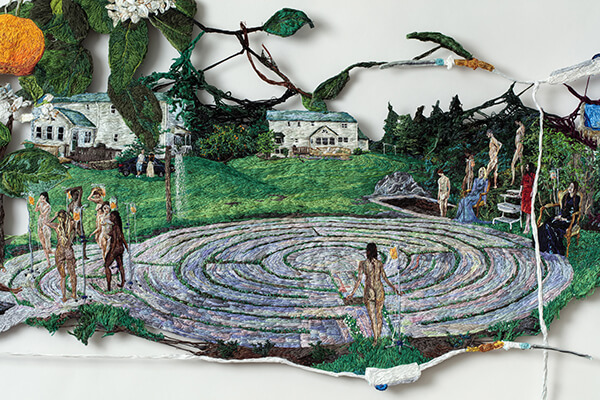

From a sex scene outside a local bank to a sleazy round of golf in a finished basement to a shrine to Entourage’s Ari Gold with a nearby copy of Aziz Ansari’s book Modern Romance, Brooklyn-based artist Sophia Narrett combines the surreal and abject with popular culture and the everyday. She creates her bizarre yet surprisingly relatable images using embroidery. Typically thought of as a craft material with a centuries-long history, including the more recent feminist coopting of the medium, Narrett’s embroideries are on view in her current show Early In The Game at Freight & Volume.
In her exhibition, Narrett unexpectedly weaves a narrative throughout the Lower East Side gallery space. Three small card-sized works act as a key or chapter heading for her larger web-like pieces in order to guide viewers through her tale. The exhibition begins with Card One: Cry, depicting a woman dejectedly holding numerous CVS bags full of beauty products, and ends with a series of works set in finished basements. Narrett sees these basements as a space for playful fantasy despite their unsettling tone. While not a conventional story per se, Narrett’s various embroideries in Early In The Game follow a similar emotional trajectory.
I spoke to Narrett over coffee at Irving Farm Coffee Roasters–around the corner from Freight & Volume–about her transition to embroidery from painting, the importance of storytelling to her work and the inspiration behind the exhibition title.
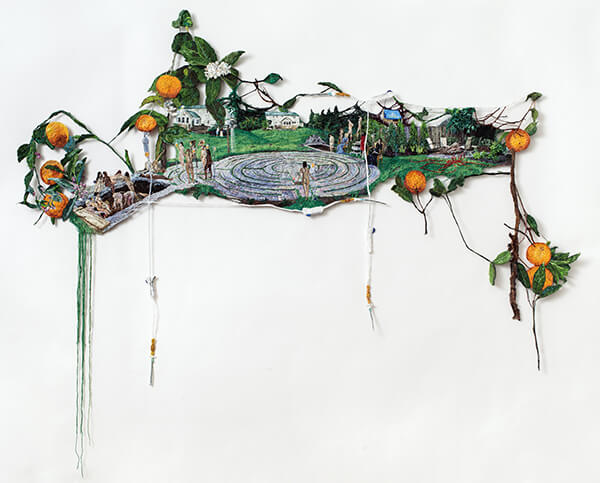
The first thing that immediately hit me about your work was your use of embroidery. You originally studied and started in painting. How did you make that transition to embroidery?
It was kind of a coincidence. Although looking back, I think it makes more sense as a natural progression, but at the time, it felt like a coincidence. I was experimenting making all these side projects in addition to my paintings. I was making little plaques and I was going to make a life-sized figure. I had all kinds of materials in the studio. So I had some thread that I was using to put details on these four-leaf clovers that I made out of felt for an installation. I was also doing drawings and one day I thought, “What if I did an outline drawing in thread.” It kind of went from there. Looking back at what I was doing, I was looking for more of a material connection than I had personally felt with paint and with the rectangular image. But in the moment, it felt really spontaneous. Thread solved a lot of the problems I had in painting–formally. That is also why I ran with it. It forced me to slow down.
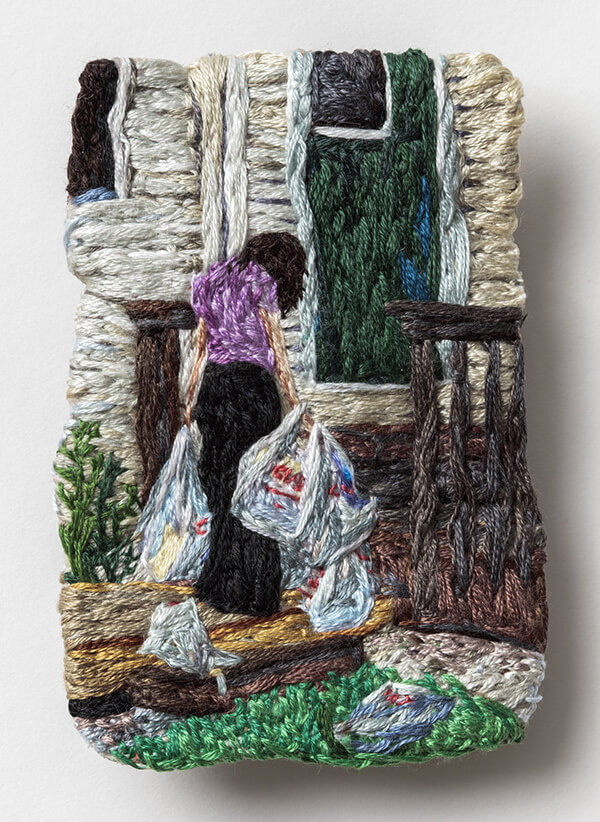

Embroidery has such an extensive inherent history, especially for women artists. Was this history what attracted you to the materials of embroidery?
Not initially–once I started working in it, I became more interested in that history. I read the book Extra/Ordinary: Craft and Contemporary Art and it was really awesome. Reading about feminist histories, I felt very interested, but also kind of disconnected. I hadn’t chosen embroidery as part of the message–consciously anyway, it was really was more of a formal, material connection that drew me to thread. Then reading this essay by Dennis Stevens, there was a part about how for Generation X and Y, etc. artists any material was on the table for art-making, after the feminist art history of people choosing craft materials as part of their message. I identified with that. That was my experience. I have encountered the odd person here or there who has made comments that it would be better if it were a painting, or somehow belittled craft. But by and large, I haven’t encountered that pushback of people trying to separate art and craft, and I had never questioned thread as an art material, so I didn’t really feel like it was a political statement to use it.
However, it is a really complicated question because even as I say all of that–anyone’s experience of the work has that residue of the history of embroidery. Even if you think you don’t know specifically about the history of embroidery, it’s in the water culturally. The associations with it are totally different than those that come with a painting on canvas. Embroidery goes back centuries, but I think about it especially in the last couple hundred years with samplers, domestic work and linens. That’s different from what I’m exploring in these narratives with sexual content or existential questions. I have a lot of freedom in what I’m doing. At the same time everyone’s work is reflective of the social landscape of the time, I don’t think I operate outside of these parameters, and I also don’t want to make assumptions or place limitations on what domestic embroidery has meant for people. It’s difficult to characterize such a vast history. These kind of historical associations have become more important to me as I get into narratives of identity and self-actualization. In one sense, I think of embroidery (and its implicit history) as helping specify the tone that my stories are told in, one characterized by obsession, desire, and both the freedoms and restraints of femininity.

I was interested in how you make these webs with the embroidery, which contrasts with the rectangular shape of a painting. It reminds me of Sheila Pepe’s work a bit with its hanging strings and strands of thread. Why did you choose these web-like shapes?
That’s been an evolution. When I first started, the shapes were defined by the hoops, in which I make them. There was this roughly circular or ovalish bent to them. But as I kept going, I started experimenting with that. This group of work is the most sculptural it’s got so far, especially with the life-size props in the borders. I’m thinking now in the studio of pushing that even further with stuff coming out of the walls.
The main reason I’m interested in the hanging thread and the dissolving borders is to get some of the emotional content into the material, as well as the image. It might sound kind of cheesy but I think of areas of abstraction as similar to the way a song can have a feeling in it. I’m such a literal and narrative-based person that it’s been fun for me to let the process take over in that small way.


What is your artistic process?
It always starts with the narrative. Sometimes, that’s very developed and other times, it’s just an idea of an image. I’ll make a reference collage in Photoshop. For that, I’ll gather images online or take images or screenshots. But most of them come from online. I’ll draw a simple outline on the fabric and then, I’ll sit in front of the computer and sew. As it goes further on, I’ll cut it out of the hoop and work on it on the wall. I have this very craft-based mindset in the sense that I’m doing something from start to finish. Starting embroidery, I felt so much freedom because I could give myself over to the process. It tells you when it’s finished. It gets to a point where you can’t get any more detail on the thread or you’ve been sewing on it for months and all of a sudden its just done.

Early In The Game traces a loose narrative throughout the exhibition, indicated by the three small card-sized works. What interests you about constructing a narrative with your work?
That’s something I’m really devoted to. This project and the last project I’ve done have an overarching narrative to all the pieces in the show. The last project was four pieces that told the story of these two women. It was an ill-fated love story. For this project, there aren’t reoccurring characters, but there’s three emotional chapters. I was thinking of the people as this collective, interchangeable group. The first chapter is this time of sadness, isolation, miscommunication and toxicity. The second is numbness and wandering. The third chapter is fun, almost frivolous, but also having a sense of relief. That’s not to say it’s a happy ending.
For me–just to have a connection to make the work, I need to be committed to the message. They’re always really personal. They’re always direct metaphors to my life at the time. I think having that underlying backbone even if it isn’t something someone might read from steps one to three, hopefully gives it a specificity that allows people to project their own narratives.
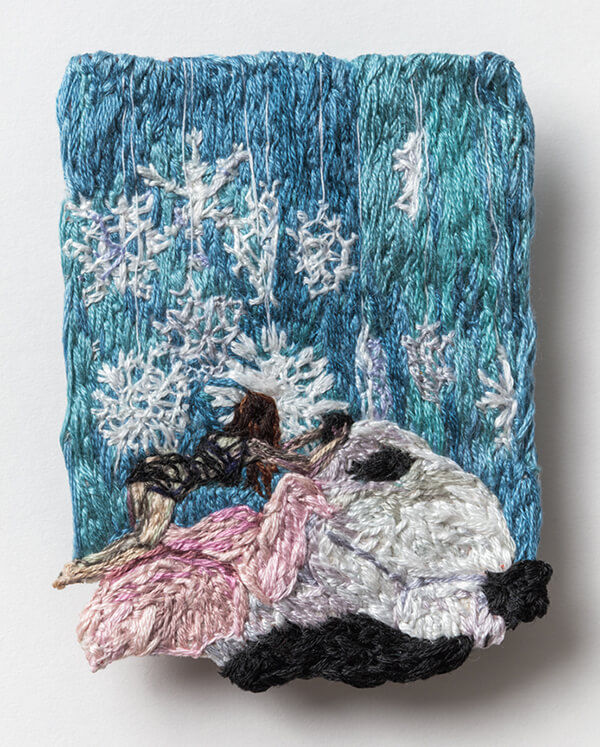
I wanted to talk about some of the content of the work too. They’re very similar to David Lynch’s representation of the surrealism of the everyday. I’m thinking about the women with the orange IV’s in Stuck or the sexual basement golf game in When Your Heart Is Open. What inspires these scenes?
The IV’s in Stuck came from researching vitamin IV drips so it’s super literal. There are these expensive therapies for health and beauty. They’re so ridiculous, but there’s this intense marketing on these websites that makes you think, “Oh, I need one of these.” I was also thinking of altered mind states and drugs. It’s all a combination of the narrative and online searching. I started off with a narrative that needed a way to visually symbolize these women in an altered mind state, which could either be of their own choosing or had been dictated to them, and was somehow emotionally healing or at least numbing. Online searching gave this image to the idea. That’s pretty much the structure of how it happens.
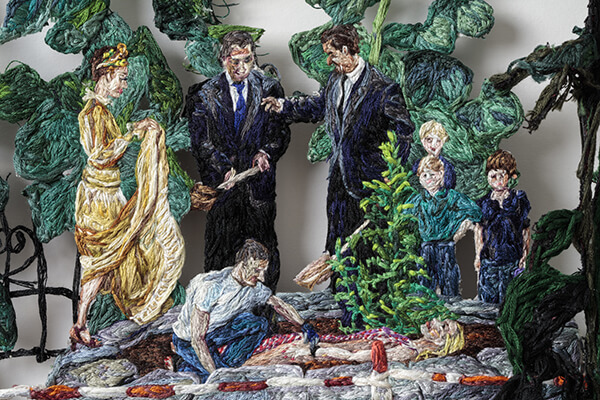
For the sexual images in the third chapter some of them have been altered, obviously, but there are images of people doing all that stuff online. I love what you say about the everyday surreal because people really do all this stuff. I wanted to think about this idea of people playing sexual and emotional games, role-play and setting parameters for interactions that let you get outside of reality. Escapism can be a good or bad thing, but I was thinking of it in a positive sense here.
Your mention of games reminds me–I was also wondering about the title Early In The Game.
I wanted to leave a sense of there not being a resolution. I’m thinking of this narrative as ending on a cliffhanger. When I was only one or two pieces into the show, I read The First Bad Man by Miranda July. That was very inspiring in that moment. The main character has an interaction, which she thinks is a very confrontational, negative situation with this girl. Then, in a therapy session, she has a realization or breakthrough that they were playing this emotional, sexual game. I love the idea of reframing an interaction as a game.

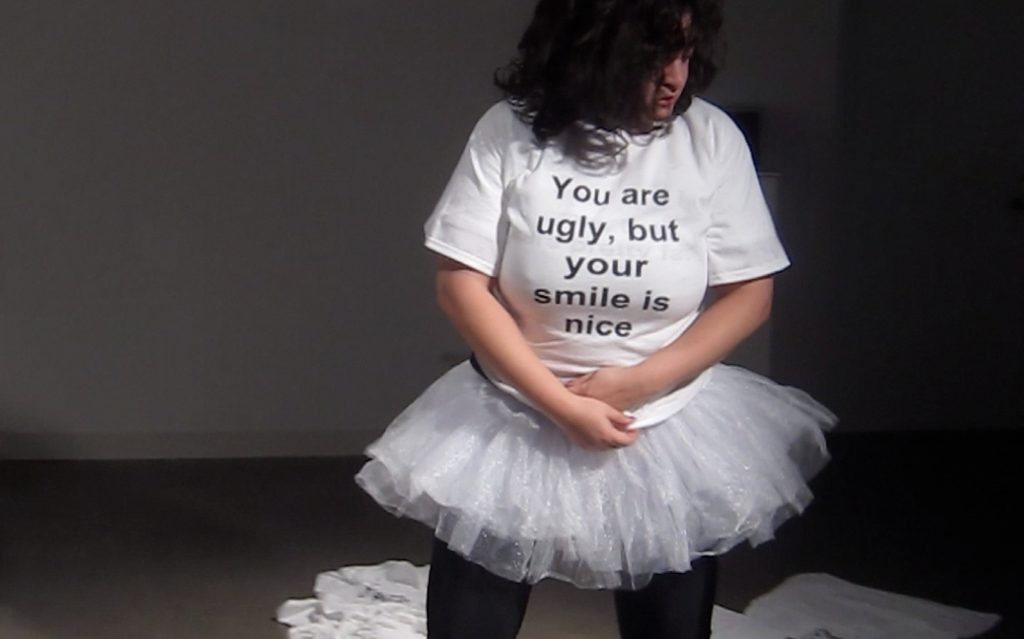



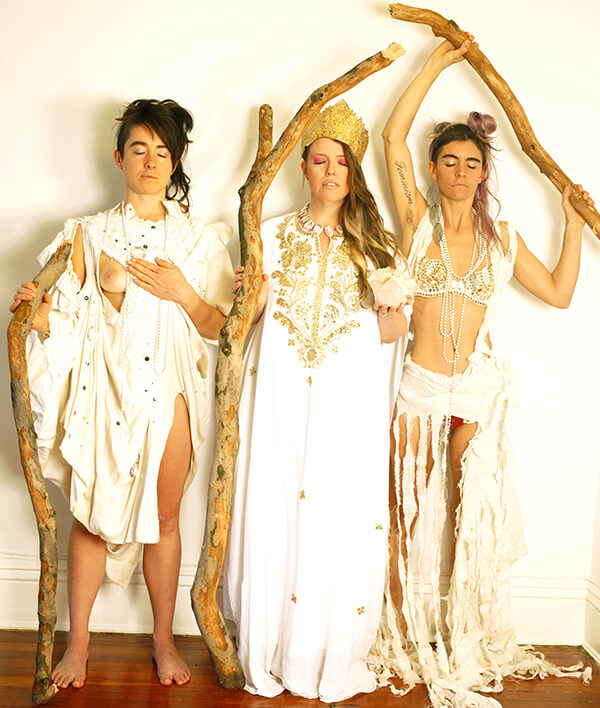

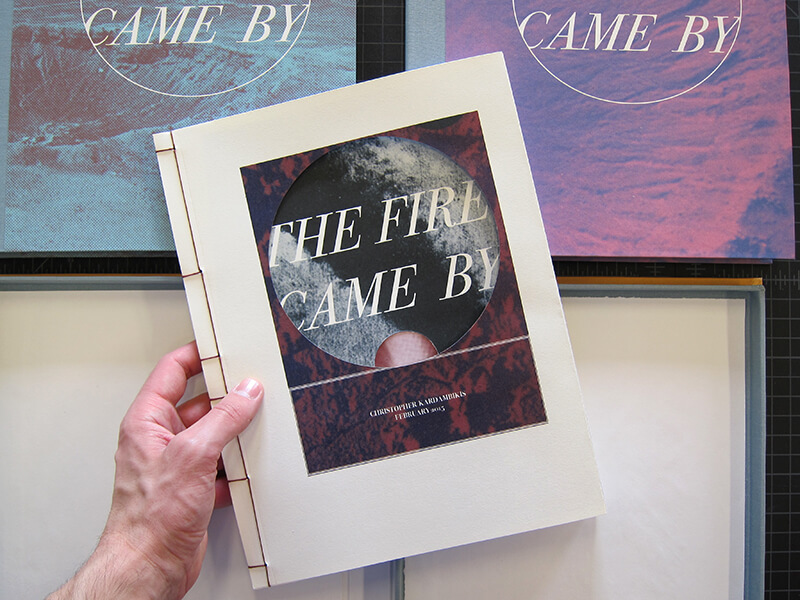
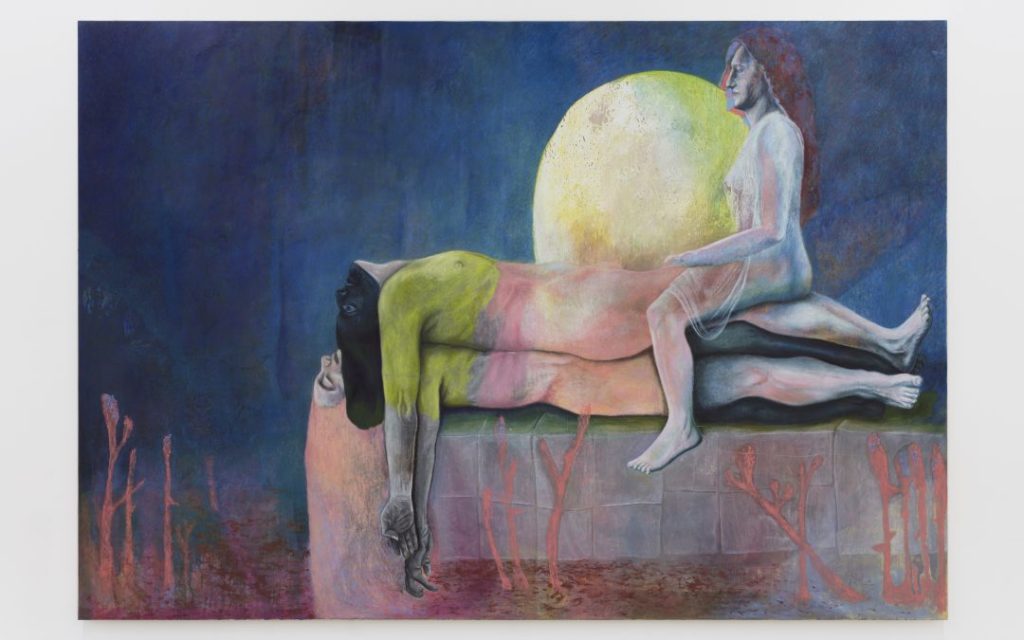
Responses